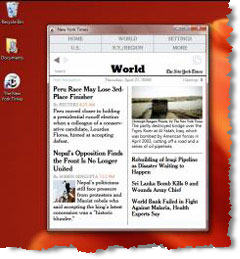Microsoft and NY Times unveil Times Reader


I say enter the mainstream because, to this day, whenever I am out and about with my Tablet PC, one of the applications I always demo is Zinio Reader. Zinio has been offering an increasing library of publications in digital format for years and I currently subscribe to more than a dozen trade and consumer titles using their service. Whether I'm traveling, sitting in a cafe, of at my desk, having a library of current and archived publications is an excellent resource.
And of course, I can carry all of these publications without any added weight or having to bother fumbling through paper copies (or dead trees as some refer to them) to find just what I want to read or reference.
There have been some gating factors to the broad adoption of on-screen reading. Most people still are not comfortable sitting in front of a computer monitor to read and prefer the mobility and flexibility that paper-based publications and books provide. Battery life is not an issue when reading a magazine or newspaper, they are highly legible in direct sunlight, and they are easily shared, recycled, or disposed after they have been read.
But the Tablet PC has changed my reading habits permanently. I read more and more books electronically as well as magazines. As a subscriber to the electronic version fo the New York Times, I look forward to the day when I can read that publication as easily as I do eWEEK, PC World, or MacWorld onscreen. Of course, I do that today with Zinio Reader. I can highlight, annotate, and bookmark these publications. I can easily print an article that I want to share with a co-worker or friend. And I can carry the equivalent of many pounds of paper without breaking my back.
Of course, the implications of Microsoft developing a reader application must be causing some concern to the folks at Zinio. Whenever the company gets into an application space, the incumbent providers of that technology know they are in for a different kind of competition than they may have faced before. But I don't think it's a foregone conclusion that Zinio is in any danger of becoming marginalized or obsolete because of this announcement.
Microsoft Reader, the company's e-book application for Windows-based PCs and Windows Mobile devices is only of a number of choices and frankly is hampered by a horrible DRM engine that makes it incredibly difficult to move content from one device to another. Windows Media Player, bundled though it may be, is only one option for consuming audio and video and alternatives are available that can play the Windows Media formats. Of course none of you need me to explain the situation with web browsers, right?
tech.memorandum has an interesting list of posts about the announcement if you want to read more.
Update: Jeff Jarvis takes a contrarian position (not an uncommon state of affairs) and writes:
"The only reasons to do this are to feed editorial ego, to think you’re maintaining editorial control, to try to dupe advertisers into thinking this the same as putting an ad in print, and to grasp desperately onto a past that is disappearing."
But then he doesn't use a Tablet PC ;^)